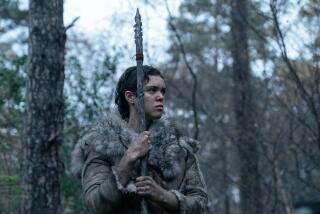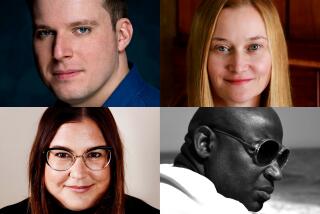Paul Tremblay, one of the new faces of horror
When I bought Paul Tremblay’s “The Little Sleep” in summer 2009, I thought I’d discovered the next great writer in outré crime fiction. I was wrong. Tremblay would become much more. Since then, the Boston-based author has changed publishers, developed a unique voice and gone from crime-writing newcomer to one of the top voices in modern horror. The transition wasn’t easy, but Tremblay was willing to talk about it when I recently got him on the phone.
His past as a crime novelist is the first thing we talk about, and it is nothing like I imagined.
“I felt a bit like an interloper, because until then, I had mostly written short horror fiction,” he says. “The Little Sleep” was an idea that clicked with a publisher, Henry Holt, and got a follow-up, “No Sleep Till Wonderland,” in 2010. However, the novels had disappointing sales. The lack of success affected Tremblay. Still, he persevered. “A Head Full of Ghosts,” published in 2015 by William Morrow, signaled the second start of his career. It was also the book that turned him into a known name in horror fiction.
“‘A Head Full of Ghosts’ is a special book for me,” Tremblay says. “After my debut didn’t go very well with Holt, I needed to be in a healthier head space. I was happy to emerge from there. You will always have those negative thoughts as a writer, but you can’t let them take over. If you let them take over, those are the real page killers.”
Stephen Graham Jones, Victor LaValle, John Langan, Laird Barron, Nadia Bulkin, Mariana Enriquez, Nathan Ballingrud... are making this the Golden Age of horror.
The book was his reentry into the horror genre. In it, a young girl appears to have become possessed by a demonic entity, throwing her household into a terrifying state of chaos and fear. The novel took off and received rave reviews. “‘A Head Full of Ghosts’ was my first full horror novel, and that felt like coming home as a writer,” he says.
A year later came “Disappearance at Devil’s Rock,” an eerie, emotionally gritty tale of a family’s collapse after the strange disappearance of a boy. The novel’s success cemented Tremblay as the newest member of horror fiction’s upper echelon and built a bigger audience for his latest, “The Cabin at the End of the World.” Published in June by William Morrow, “The Cabin at the End of the World” is a tense, thought-provoking tale of two fathers and a daughter who are trapped in a cabin by a group of individuals requesting a sacrifice to fend off the apocalypse.
“‘The Cabin at the End of the World’ came from a fun moment of inspiration,” says Tremblay. “I’d been invited to the Los Angeles Times Festival of Books when I received the news that the [previous] book I had pitched wasn’t going to happen. I had to come up with a different novel.” Tremblay got home and dug into the notebooks he uses to generate ideas. Soon, the thought of writing a home invasion narrative came to him. “The thing is, I really don’t like home invasion stories,” he says. “I think everyone’s had that fear at some point, so there’s a connection, but I read them for the violence and not much more. So I told myself, ‘OK, Mr. Bigmouth, how would you write a home invasion novel?’ Then I sat down and watched a lot of home invasion movies.”
The movies were followed by a summary, which was accepted, and the writing began. For Tremblay, the writing process was unusual this time around. “I’m not going to say writing this book was easy,” he says. “It wasn’t. Every book is hard. But this one was different. It was slow, but consistent.”
Apart from consistency, something happened that had never happened before: Current events affected Tremblay’s writing. “It was easy to have the anxiety of the times seep into the book,” he says. “For the first time, I had a subtext in mind: the current sociopolitical situation.” In fact, the political atmosphere affected the book so much that the author changed the ending after the 2016 elections.
“The Cabin at the End of the World” places readers in a situation where ambiguity permeates everything. It’s an element that has been present in Tremblay’s last three novels, and it proves he is a masterful storyteller in full control of his narratives. “The ambiguity is something that happens organically,” he says. “Ambiguity is there to reflect our reality. That’s what binds my three books together. Ambiguity is a big part of this post-truth world we’re living in. There are big apocalypses and small apocalypses, and ambiguity helps me explore all of them.”
To Tremblay, horror is a “big tent”; he proves it with prose that pushes up against literary fiction and a persistent sense of weirdness in all his books. Before letting him go, I asked where he thinks his novel fits in contemporary literature.
“I want folks to take horror seriously,” he says. “They say we are living in the Golden Age of horror, and I agree. Folks like Stephen Graham Jones, Victor LaValle, John Langan, Laird Barron, Nadia Bulkin, Mariana Enriquez, Nathan Ballingrud, and on the YA side, Hillary Monahan and Amy Lukavics are making this the Golden Age of horror. It’s definitely the most diverse age. I want to add my work to the group of horror stories I like.”
The world is full of horrors, and “The Cabin at the End of the World” is a book that helps us imagine a way of navigating through an apocalypse with immediate, devastating consequences. That makes it required reading for anyone trying to make sense of our times.
Iglesias is a writer, journalist and book reviewer living in Austin, Texas. He is the author of the novel “Zero Saints,” the book review editor for Pank Magazine and a columnist at LitReactor.
More to Read
Sign up for our Book Club newsletter
Get the latest news, events and more from the Los Angeles Times Book Club, and help us get L.A. reading and talking.
You may occasionally receive promotional content from the Los Angeles Times.






